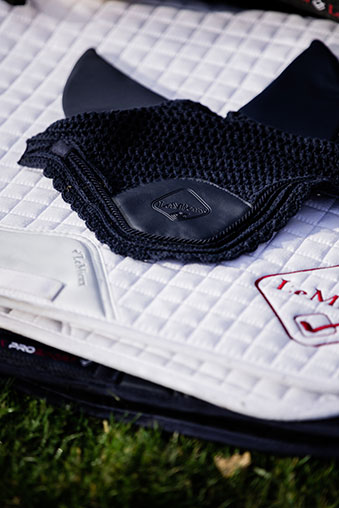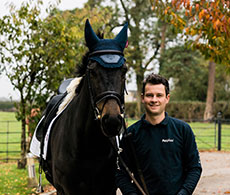
Training exercises with Petplan Equine Ambassador Jack Stancombe
Whether you are currently preparing to take part in a Petplan Equine Area Festival or you are just wanting to improve your flat work, we have teamed up with our ambassador Jack Stancombe and equestrian brand Le Mieux, to provide you with expert tips and exercises. All of which you can incorporate into your training at home to help you prepare for your next competition.
About Jack
Normally found out on the cross country course, Jack has decided to focus more closely on his dressage career. Riding Watermill (Milla), a seven-year-old mare, the pair have been competing at Novice level and Jack is aiming to step up to Medium with her next year.
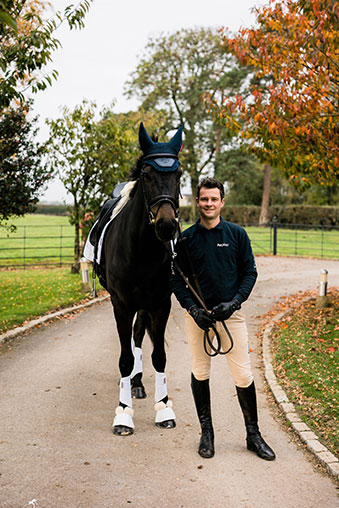
Jack’s Le Mieux kit
Milla wears a Le Mieux embroidered dressage square, Pro-Sorb Lambswool half pad, ProShells brushing boots, Lambskin over-reach boots and Acoustic fly hood. Jack wears the Le Mieux classic riding gloves.
1. Improving your seat and your horses’ suppleness and balance
Improving your seat
To begin with Jack talks to us about improving your seat as this is something you can practice at the start of your training session.
“It may seem a bit of a classic approach, but I would say there is nothing better than working without stirrups or even a lunge lesson to improve your position. Sometimes just even walking around the arena without your feet in your stirrups when you first warm up your horse - providing he is not sharp and you are confident doing so – can almost instantly give you a better seat,” comments Jack.
“It encourages you to sit taller in the saddle as well as increasing your balance and core strength. It is essential that you carry your body weight down and through your leg and do not take it all in your seat. You must not use the reins for balance, so if you are just starting out or you are a bit out of practice, remember to do little and often, especially if you are working in trot or canter.”
“Addressing your own strength and fitness will also help you improve your position. You must be able to stay strong in your core whilst also remaining supple which requires a degree of fitness. Strengthening and stretching exercises will be beneficial to your seat.”
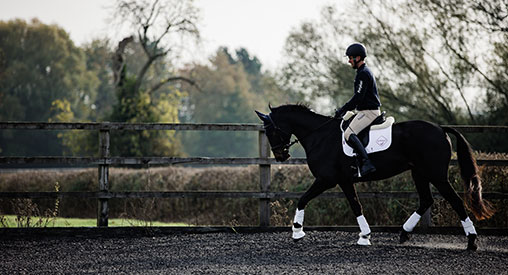
Developing your horses’ balance
Next Jack shares his advice about improving your horses’ balance.
“One exercise which often helps me is to ride downwards transitions within each pace. For example, I would start by riding a few strides of a smaller, more collected trot using half halts then riding forwards again into a more powerful working trot. This will help your horse to have a more balanced trot to walk transition. You can also do this in canter before moving back to trot. Be sure to ride your half halt correctly; engage your stomach muscles, and squeeze your fingers around the reins, making sure it is a quick and effective movement which gives clear instructions,” says Jack.
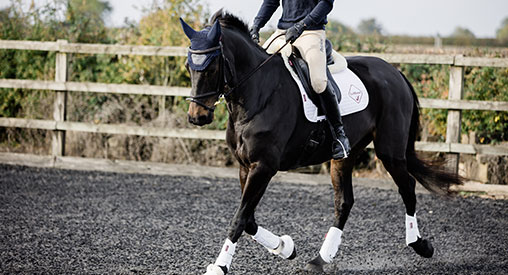
“This is a good exercise to practice as you will need this when riding a test. It can help you pick up extra marks when riding into corners and producing tighter more accurate turns onto the centre line,” Jack explains.
Working to improve suppleness
“This next exercise can be used at the start of your session or at the end as it not only helps with suppleness but encourages your horse to stretch. Whilst we aim for the horse to stretch at the beginning of any flatwork session, some horses do find it easier at the end when they are more connected.”
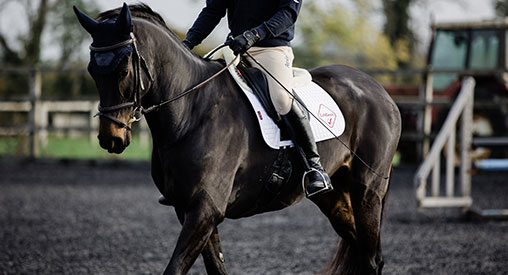
“First, ride straight down the centre line, your horse must be straight.” emphasises Jack. “His ears must be level and your shoulders must be in line with the fence of the short side of the school. Once you have perfected this, develop the movement and ride straight down the centre line but asking for either right or left flexion at the poll. This helps with suppleness also. Remember if you have to use your outside rein to keep your horse on the track then your rein is essentially acting as your inside leg which may mean you’re asking your horse to bend to the outside rather than flex,” adds Jack.
Kit focus: Jack uses the Le Mieux embroidered dressage square and Pro-Sorb Lambswool half pad. The Pro-Sorb half pad helps fine tune the saddle fit and provide comfort.
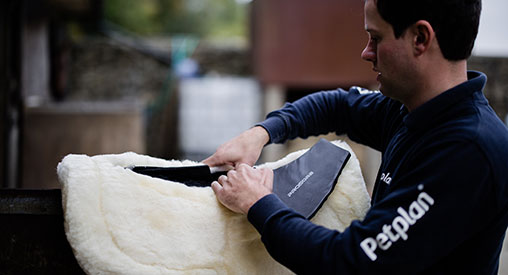
2. Incorporating lateral movement
Lateral movement is so important because it helps your horse with suppleness, even at the lower levels of dressage it can really help your horse’s way of going. When incorporating shoulder-in and leg yielding into your training routine, Jack suggests to start practicing whilst out hacking. “If safe to do so, such as a quiet lane or farm track, start introducing leg yields and shoulder-ins while riding down the track.”
“Starting to incorporate lateral movement can seem daunting, but it is really quite simple once you get the hang of it,” comments Jack.
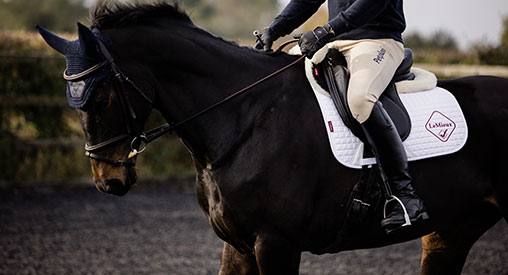
The leg yield
“Teaching your horse to leg yield is so beneficial. It helps improve his straightness, suppleness, contact and acceptance of the aids,” begins Jack. “To ride a leg yield, your aids must work together but provide clear instructions. The inside leg should sit on the girth and asks the horse to move to the side, while the outside leg sits a little behind the girth and asks the horse to continue forward. The inside rein asks for slight flexion in the opposite direction of travel and the outside rein helps maintain straightness and rhythm.”
“Make sure the horse continues to move forwards and does not sacrifice going forwards for stepping sideways. Do not let him speed up, you need to remain in control. I will often ride a few steps, then allow the horse to go straight and then ride a few more steps in leg yield. This also helps if the horse runs too fast.”
Shoulder-In
Shoulder-in has many benefits, as Jack explains, “You can use shoulder-in as a suppling exercise. It also helps you collect the horse as well as teach straightness.”
“Shoulder-in places the horse’s hind legs on the line of travel whilst the horse’s shoulders are off the track positioned to the side. Your horse should be bending his body around your inside leg with the poll flexed to the inside, away from the direction of travel.”
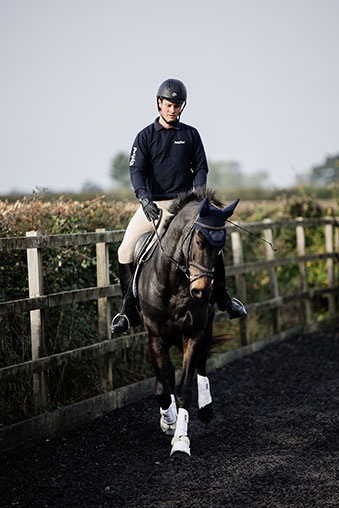
“To improve this movement, try not to start with too big an angle and work along the long side of your arena. You don’t want to just pull the inside rein as this leads the shoulders off the track. The inside leg pushes the rib cage and inside hind into the outside rein. The outside rein catches the shoulder and the outside leg behind the girth keeps the haunches from falling out. As you approach your chosen long side, it can help to almost prepare for a change of rein across the diagonal before asking for shoulder-in,” adds Jack.
Travers
“Travers, when used in training can help improve the bend, your engagement and contact with your horse.”
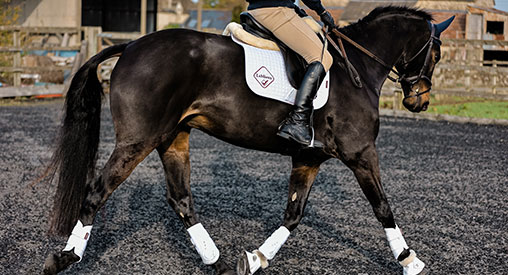
“Start with a ten-metre circle before moving into travers up the long side of the school. I do this to make sure the horse is properly bending around my leg before I move into a more advanced movement. The use of a fence or wall will help guide you before you feel more confident using this lateral movement across a diagonal.”
“Your horse’s front end in travers needs to be travelling straight. Your inside leg is on the girth asking for the inside bend, while your inside rein controls the shoulders, keeping them straight. The outside rein controls the speed whilst the outside leg stops the haunches from falling out.”
“You need to be sure you don’t use too much outside leg and almost cause your horse to move into a leg yield. Another common mistake is to pull too hard on your inside rein and ask for too much of an angle as your horse will fall on his forehand,” explains Jack.
Jack’s top tip: Try to turn your hips a little to the outside. This helps you to put a bit more weight into your inside stirrup to help create the correct angle.
Kit focus: Jack uses the ProShell brushing boots and Lambswool over reach boots. Both provide all round protection.
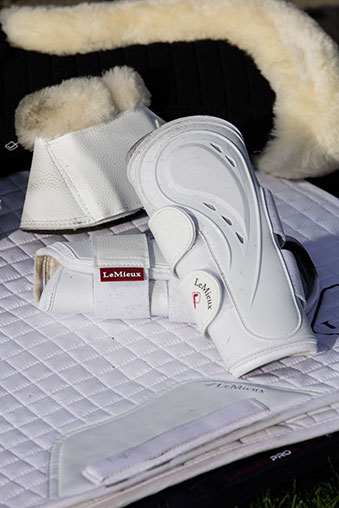
3. Preparing your horse for the competition arena
Preparing your horse for a competition environment can be very beneficial and may help to reduce your nerves on the day. Whilst you will never be able to fully replicate every element of a competition there are things you can do at home to try and desensitise your horse to some of the aspects involved at an event, as Jack explains.
“Familiarising your horse with sights and sounds prior to a competition isn’t just useful for novice horses, but also those which may have had some time off. Also knowing your horse is settled in that kind of environment will help you relax more on the day,” remarks Jack.
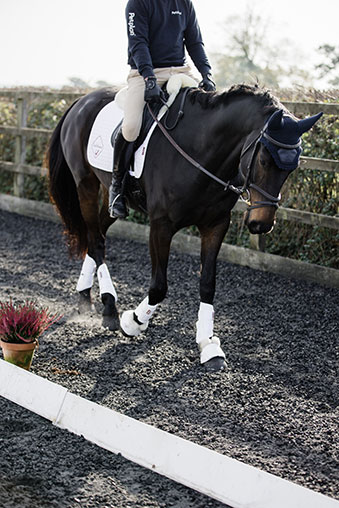
The warm-up arena
“The warm-up arena can be one of the most daunting aspects of going out competing. Many of us will work in an arena on our own or only with one or two other horses, so a warm-up arena can seem exciting to your horse. If you can and it is safe to do so, try to work at home with other horses in the arena to help get your horse get used to others riding past him.”
Getting your horse used to a dressed arena
“It may seem obvious, but using flower pots or banners around the side of the arena or just on the yard can help desensitise your horse to objects he might not see every day. If you don’t have any banners, a flag or even a sheet are good alternatives which you can drape over the side of the arena.”
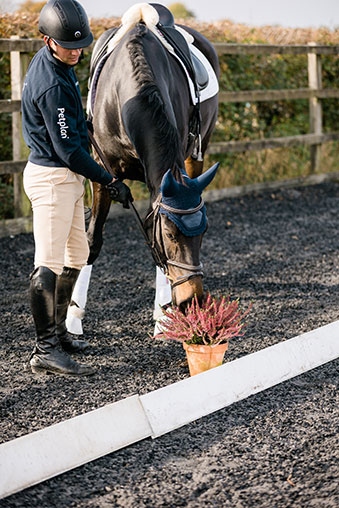
“Whether you work in an arena or a field, put dressage boards or poles out so you are used to working in a 20 x 40 arena, as it’s easy to not use your corners when you’re working in a bigger space. If your horse is a novice this will also get him used to working inside the boards.”
Have a practice run
“If someone on your yard is going to a competition, why not see if you can tag along with them. You don’t necessarily need to enter a class but if it is a smaller show it might be good practice for your horse. Take him to have a look around and familiarise himself with the sights and sounds and being in the company of other horses. It also gets your horse out to somewhere different, thus adding to his experience,” concludes Jack.
Kit focus: Jack uses the Le Mieux Acoustic fly hood, which can absorb sharp or loud noises to help with increased concentration and relaxation.
